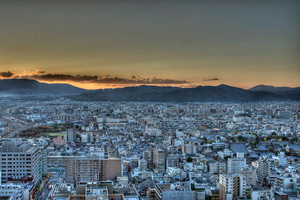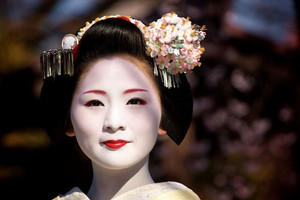
Japan’s former imperial city is home to some of the country’s most famous architecture, and Ben Hall finds a few hidden delights by asking the locals what they do on their day off.
As the sun drops low over the city, a warm orange hue is cast across the sprawl of buildings and shrines below and through the mountains that ring the urban landscape. As the sunset gathers momentum, young ladies in traditional kimono queue at the purification wells for a ritual cleansing before praying at the temple, in the hope that they’ll be lucky in love.
This is Kiyomizu-dera at its best and at this time of day, and with the added benefit of perfect weather, it’s easy to see why the temple complex is one of the most revered in Japan.
On good advice from a local, we arrive at one of Kyoto’s most famous monuments one hour before sunset and wander the temple and shrine complex and then grab the best spot near the entrance to Kiyomizu-dera before the sun drops behind the mountains.
The reward is one of the most memorable and evocative sunsets which bathes the temples and pagodas which tower over the city and surrounds, and it’s thanks to local knowledge that we’re in the right place at the right time.
Our inside info on Kyoto came from a young woman working at our hotel who had lived and worked in the city most of her life and another student studying English in a coffee shop. While their tips weren’t earth-shattering revelations, it’s what the local people do on their time off from work and it resulted in a couple of experiences which most visitors miss out on.
The Kiyomizu-dera sunset was the end of a walking route called Tetsugaku no michi, or the Philosopher’s Path, which is basically a pretty stone path that runs beside the canals of the Higashiyama district in the north-east of the city. The path is lined with hundreds of cherry trees which blossom in April but it’s still a wonderful two kilometre walk at any time of year and it begins at Ginkakuji, also known as the Silver Temple, which is another of Kyoto’s top attractions.
The Philosophers Path is lined with restaurants and cafes and boutiques along with several temples and shrines which seem to appear every few minutes and there are so many of them they simply don’t bother putting them on the tourist maps. Apparently Kyoto philosophers did indeed walk this path, and Japanese ladies often head for this area in traditional kimono to be photographed in front of the temples and shrines in the area, including the Honen-in Temple.
The Philosophers Path ends in the neighbourhood of Nanzenji which itself has a big and impressive temple complex and from here it’s possible to pick your way through the streets of Kyoto past other temples and shrines for another two kilometres before arriving at Kiyomizu-dera, and stop for traditional Japanese tea along the way.
For a totally different local experience, we were told Arashiyama on the north-western edge of Japan in the foot of the mountains is a popular tourist area with Japanese people and surprisingly few foreign visitors venture up this way.
It’s a little bit different to the overwhelming array of temples and shrines that are spread throughout Japan's former imperial capital. The area is famous for its Bamboo Forest (which featured in the film Memoirs of a Geisha for good reason) and it’s a lovely trail that leads to another of the area’s famous attractions, the Tenryuji Temple.
Tenryuji-ji, or Temple of the Heavenly Dragon, was built in 1339 and is ranked as one of Japan’s “top five zen temples” and is also famous for its beautifully landscaped gardens. Local ladies come here for tuition in the traditional art of the tea ceremony and it’s possible to watch the lessons (from a distance) where the intricate subtleties of this important cultural activity are revealed.
The countryside is stunning and we were advised to take the Sagano Romantic Train, which is a 30 minute journey beside the Hozu River up to Kameoka. It’s an open train and it’s possible to combine the train ride up and return on a two hour Boat Tour down to Arashiyama through tiny rapids. And the reason it’s called the “Sagano Romantic Train” is that at the end, the conductor serenades passengers with love songs on his microphone, and apart from that there’s nothing terribly romantic about it - it’s just a very pleasant train ride through an idyllic canyon.
It’s all very Japanese, and it’s obvious that this is what the locals love doing and it’s an authentic way to finish a visit to one of the country’s most enduring cities.
When to go:
The best times to go are spring (March to May), during the cherry blossom season, and in autumn (September to November). Summers in Kyoto are hot and can be humid, and the winter is cold. June is the rainy season.
Getting around:
Kyoto has an intricate and efficient network of bus routes providing a cost-effective way of getting around and this is the best way to get to Ginkakuji and Kiyomizu-dera. There is a visitors’ information centre in Kyoto Station which can provide bus maps, and advise which passes are best. Japan Rail also has English-speaking staff in Kyoto Station who sell tickets for the 12 minute JR train ride to Saga Arashiyama Station. Most buses and trains have announcements in English. Some areas are best done on foot, such as Gion, and an alternative is hiring a bike. Taxis are convenient but can be expensive.
Information:
For more information visit www.jnto.org.au.
Where to Stay:
Hotel Granvia Kyoto is a 535 room luxury hotel located in the striking JR Kyoto Station building which also features a department store, a museum and a vast underground shopping mall. Hotel guest have easy access to transport throughout the area. Visit www.granviakyoto.com.
Getting There:
Jetstar flies to Osaka and Tokyo. Call Jetstar on 131 538 or visit www.jetstar.com. Japan Airlines also operates daily direct flights to Tokyo from Sydney and Brisbane. Call Japan Airlines on 1300 525 287 or visit www.au.jal.com/en. Qantas operates direct flights between Australia and Tokyo. Call Qantas on 13 13 13 or visit www.qantas.com.au. Connections from Tokyo and Osaka can be made by Shinkansen “Bullet Train”, and from Osaka by bus. Visit Japan Rail atwww.japanrailpass.net.
For the latest exchange rate on the Yen, visit our partners at XE.com
- By:
- Ben Hall

















